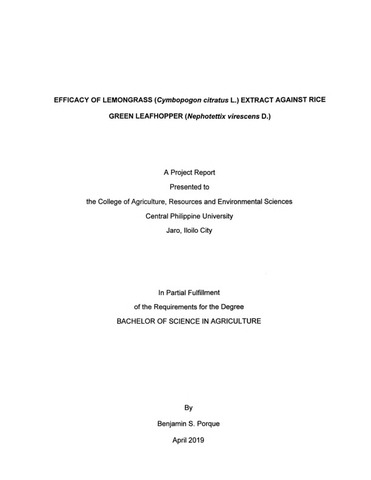Efficacy of lemongrass (Cymbopogon citratus L.) extract against rice green leafhopper (Nephotettix virescens D.)
| dc.contributor.adviser | Seredrica, Ma. Victoria C. | |
| dc.contributor.author | Porque, Benjamin S. | |
| dc.date.accessioned | 2021-07-06T02:15:52Z | |
| dc.date.available | 2021-07-06T02:15:52Z | |
| dc.date.issued | 2019 | |
| dc.identifier.citation | Porque, B. S. (2019). Efficacy of lemongrass (Cymbopogon citratus L.) extract against rice green leafhopper (Nephotettix virescens D.) (Unpublished Special paper). Central Philippine University, Jaro, Iloilo City. | en_US |
| dc.identifier.uri | https://hdl.handle.net/20.500.12852/1164 | |
| dc.description | Abstract only | en_US |
| dc.description.abstract | The study was conducted on November 23, 2018 to March 15, 2019 at the College of Agriculture, Resources, and Environmental Sciences Research and Development area, Central Philippine University, Jaro, Iloilo City. This study aimed to determine the efficacy of lemongrass extract (LE) against rice green leafhopper (GLH) as a biopesticide. The experimental treatments consisted of different levels (20%, 25% and 30%) of LE together with commercial insecticide as positive control and distilled water as negative control. These were laid-out in a completely randomized design with three replications. Ten pairs of adult GLH were introduced per treatment inside an experimental cubicle planted with rice. Results in mortality of GLH revealed that the use of LE at 20% showed an insect mortality of 56.67% after 24 hours of application. Furthermore, the use of LE at 25% and 30% resulted in a 71.67% and 76.67% mortality, respectively. The mortality of GLH continued to increase with time from 48 to 96 hours. These results in mortality of GLH indicated that even at low concentration (20%) of LE a 100% mortality can be attained within 4-5 days from spraying. LC50 done 24 hours after the application of LE showed that a concentration of 17 x 104 ppm is needed to kill 50% of the GLH population while LC90 conducted 72 hours after application of LE revealed that a concentration of 27 x 104 ppm is needed to kill 90% of the GLH population. Furthermore, there is no significant difference on the plant height and number of tillers of the rice plant among the treatments sprayed with the different levels of LE. | en_US |
| dc.format.extent | x, 48 leaves | en_US |
| dc.language.iso | en | en_US |
| dc.subject.ddc | Filipiniana Theses 630.72 P827 | en_US |
| dc.subject.lcsh | Lemongrass | en_US |
| dc.subject.lcsh | Plant extracts | en_US |
| dc.subject.lcsh | Leafhoppers | en_US |
| dc.subject.lcsh | Leafhoppers--Control | en_US |
| dc.subject.lcsh | Pesticides | en_US |
| dc.subject.lcsh | Natural pesticides | en_US |
| dc.subject.lcsh | Botanical pesticides | en_US |
| dc.subject.lcsh | Pesticides--Evaluation | en_US |
| dc.subject.lcsh | Botanical pesticides--Evaluation | en_US |
| dc.subject.lcsh | Natural pesticides--Evaluation | en_US |
| dc.subject.lcsh | Botanical insecticides | en |
| dc.title | Efficacy of lemongrass (Cymbopogon citratus L.) extract against rice green leafhopper (Nephotettix virescens D.) | en_US |
| dc.type | Special paper | en_US |
| dc.description.bibliographicalreferences | Includes bibliographical references | en_US |
| dc.contributor.chair | Cabarles, Jaime C. Jr. | |
| dc.contributor.committeemember | Patricio, Hope G. | |
| dc.contributor.department | College of Agriculture, Resources and Environmental Sciences | en_US |
| dc.description.degree | Bachelor of Science in Agriculture | en_US |
| local.subject.scientificname | Cymbopogon citratus | en_US |
| local.subject.scientificname | Nephotettix virescens | en_US |





